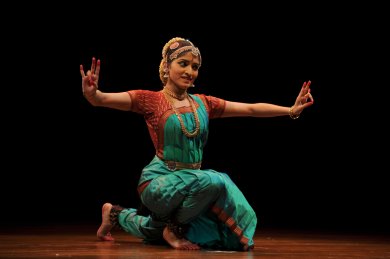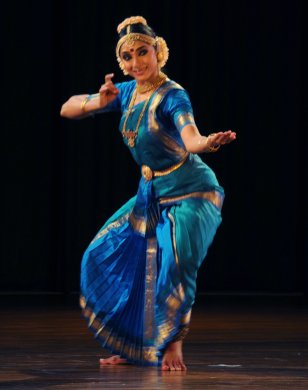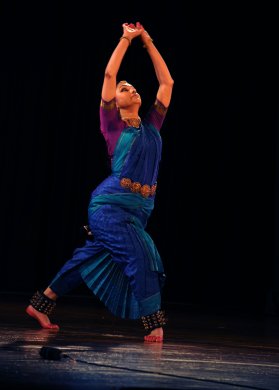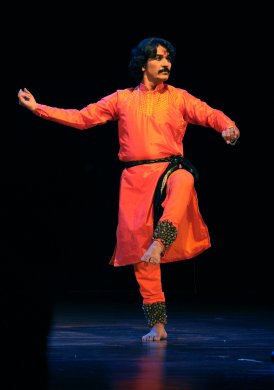
|   |

|   |
The Madras Music Academy Dance Festival - Day 6 - Veejay Sai e-mail: vs.veejaysai@gmail.com Photos: Thanthoni January 20, 2017 A photocopy of confusion  The first morning performance was a solo by Sukanya Kumar, a student of Priyadarsini Govind and Kalanidhi Narayanan. From the Academy brochure we know that Sukanya is also learning Kathak from Meenal Kher Chakradeo in San Diego. Sukanya began her performance with a piece that her guru presented a few seasons ago in this very festival. A koutuvam in the form of a Thiruppugazh of Arunagirinathar’s “Muthaitaru” set to ragam Shanmukhapriya and misra chapu talam. While everything about the presentation was identical, Sukanya had lesser energy in presenting her piece. If the whole point of this piece was to help the dancer warm up before the main piece, it didn’t help. She also kept flashing a smile as she seemed very happy to dance this piece. The main piece of the performance was “Mohamaginen,” the Dandayudhapani Pillai varnam set to ragam Kharaharapriya and adi talam. The attempt at presenting this was good but Sukanya has no stage presence. In her nritta, even as Jayashree Ramanathan provided a great accompaniment on the nattuvangam, Sukanya’s basic ‘kita thaka thari kita thom’ flourishes were left incomplete. The smile we saw earlier had by now turned into a frown. Was Sukanya already bored of performing midway through a varnam? Unless that is the case, Sukanya has to work a lot on her mukhaja abhinayam. Her face expressions didn’t go with the theme of the varnam or the mood of the nayika. Nandini Anand, who by now probably has been singing for every other dancer, had a fatigued voice. This was not helping the dance as she kept going off pitch time and again. After the varnam, Sukanya preformed the famous Kshetrayya padam “Mogadochchi Piliche” set to ragam Sahana and misra chapu taalam. Repeating the same choreographic mistakes her guru did, Sukanya was a photocopy of total confusion and chaos. ‘Piliche’ is to call. The sancharis showed a nayika being dragged by her left hand! Added to all this, Nandini kept singing “Balyam andu pottu katti.” There is a huge difference between the words ‘Bottu’ and ‘Pottu’. Bottu is used for a mangalasutram that a married woman wears. Pottu is a fruit or a vegetable peel in Telugu. They are nowhere close to each other even to signify. Nandini kept singing ‘Pottu’ and one imagined some piece of peel hanging around Sukanya’s neck! Poor Muvva Gopala must have been mighty confused about his nayika going around with a peel on her neck! Sukanya’s attempt at the javali “Yera ra ra” had no spark in her dance either. She concluded her performance with an Oothukadu Venkata Kavi thillana in ragam Surutti. Sukanya had several good qualities to become a better dancer. She needs to work a lot more on getting her facial expressions, the clarity and precision with which she presents her nritta and this will help her manage her stage presence better. Eyes that dance  The second performance for the morning was by Meenakshi Sreenivasan. Meenakshi opened her performance with a composition of poet Subramanya Bharati. “Mata Parashakti” was an ode to the divine mother goddess. For an unusual opening to her performance, this was choreographed well. Glorifying the mother goddess and extolling all her divine and esoteric forms in the simple yet effective choreography was a fresh start. The main piece of the performance was the varnam “Mohamaginen.” The second time in the same morning we were watching it! The good side of it was that the audience had a comparative analysis of the better version. The flip side of it was many who had already sat through the earlier one decided to leave. Can dancers who are in sub-senior and senior slots request a change in their performance schedule if they know they are repeating items? This would help the audiences also! Meenakshi’s choreography of the varnam was different in its own flavor. Her usage of hastas specific to the Pandanallur school she trained in, her foot work and crips jatis were worth noticing along with Jayashree Ramanathan’s excellent nattuvangam. More than all these were her eyes! Some of the expressions on her face, her mukhaja abhinayam were priceless. There was more dance in her eyes and expressions. Conveying one’s heartbeat through the eyes is an art form Meenakshi has mastered and performs with ease. As the nayika has a vision of lord Nataraja in the temple, we saw more of Meenakshi’s eyes dance. While the varnam was a repeat, the treatment given to it was far more mature and different from what was performed earlier. Meenakshi continued her performance with ‘Agni Pravesham’, a well known episode from the Ramayana. Based on Valmiki Ramayana and translated into Tamil by Prof Raghuraman, this piece was a pale attempt of what it could have been. The translation was not as literary in its merit from the Sanskrit original where each line, word, syllable and sentence mean several things at the same time. This reflected in the literal choreography of the piece. While the music set to this was far better in ragams like Abheri, Kuntalavarali, Sahana and Dwijavanti, it seems a little too crammed in composition. The ending of this piece suddenly had Sanskrit coming in for no apparent reason. The piece needs a lot of reworking in terms of the ideas it has within its choreography. Several elements need reconsideration from the musical component to the visualization of episodes. This wasn’t one of Meenakshi’s best pieces. She concluded her performance with a thillana in ragam Bilahari composed by Rajkumar Bharati. Hariprasad’s singing was strained. While the overall presentation was good in many aspects, it could have been far better than what it was, from intelligent selection of pieces to perform, to the various choreographies in pieces. She must challenge herself, both physically and intellectually, with more and produce better results. Meenakshi is undoubtedly one of the more intelligent, articulate and highly promising dancers we have in the field today. More power to her! A heartfelt tribute  After her main varnam, Rama Vaidyanathan paid what could have been a beautiful tribute to the city of Chennai. In the recent cyclone that preceded the Margazhi season, a lot of damage was caused to thousands of trees. Several of them which were over a hundred years old came down. There was total chaos in what could have been the lung spaces of the city like the Theosophical Society, IIT campus, Nageshwara Rao Park and several other parks. In her ‘Vrikshanjali’, Rama paid an ode to the trees of Chennai that keep the weather in bearable conditions. The concept of trees being static and dynamic at one time was explored in the choreography of this piece. Using ragams like Hamir Kalyani and other sober melodies, Rama’s tribute was heartfelt and genuine. She opened the evening’s performance with a Mallari and an excerpt from the Mukunda Mala. But her main piece for the evening was the varnam “Karuna choodavemi sakkani saami” set to ragam Athana and adi talam, a less performed one of the Thanjavur Quartet. One was the selection of the varnam itself. By the second last day of the Academy’s festival we had enough of ‘Mohamaginens’, enough ‘Saami ninne koris’ and the like. One more of those would have been overkill. Rama’s selection was fresh and original. The ragam Athana with all its emotional weight was explored by Venkateshwaran’s balanced and melodious singing. In the second half of the varnam when the nayika says “Pantamela chesevu naato” questioning the lover why he is trying to brew a pointless fight, the raga vistaaram matched the choreography of the sancharis in the lyrics. What can one say about Rama’s choreography and nritta! Both were fantastic and highly energetic. Few dancers of her stature get this quality of precision. Vasudevan Iyengar’s nattuvangam enhanced the nritta portions. Except there was a section of the audience loudly pointlessly cheerleading for every jati and sanchari! It was an odd feeling for everyone else in the auditorium. If they were students or fans of Rama, they should know they weren’t doing any good to her performance by behaving like groupies and making it seem very silly. After the varnam was the ‘Vrikshanjali’ as mentioned earlier, followed by famous Subrahmanya Bharati song “Aasai mugam.” The pathos of Bharatiyar’s poetry was reflected in the choreography of the piece. The Sakhi laments at having forgotten the face of Krishna. Rama’s attempt at viraham was at its best. The piece could have been a little slower in its treatment to enhance the mood of lament. Rama concluded her performance with a Surdas Bhajan “Murali naad sunayo, aaj hari adbuth raas rachaayo.” Hearing the melodious music of Krishna’s flute, hundreds of Gopis are intoxicated and dance in ecstasy. They find Krishna dancing with each of them in a Maha Raas. If one knows the context in which the blind poet Surdas visualized this song, it is a very moving experience. Rama’s brilliant choreography showing how each Gopi finds her Krishna and dances along was an ode to Surdas’s bhakti for Krishna. Rama’s performance at the Academy was easily one of the best among the ladies who performed in the prime time evening slot. Except for the annoying and intrusive cheerleading in the audience, it was an enjoyable show. The colours of Jaipur Dressed in a shocking plain bright orange satin kurta and pyjama with a shiny black kamarband, Rajendra Gangani made his entry onto the Academy stage in his Kathak solo in the last performance for the day. While initial reaction was one of shock, one can understand the selection of such a colour by an artiste who hails from the rich heritage of the Jaipur Gharana. If you saw the principal colours of Rajasthani costumes, bright turbans and angarkhas, it would be easier to place Rajendra’s attire in context. But Rajendra Gangani came across like one of the many dubious sanyasis one encounters in Banaras, and with loose threads dangling, the costume looked shabbier. Why wasn’t aharya important to the dancer for such a prestigious show?  Rajendra began his performance with a Shiva Stuti. Based on Adi Shankara’s ‘Shiva Panchakshari Mantra’, the choreography of it was very basic. The singer Vinod Gangani’s voice was barely audible. Rajendra took time to warm up with this piece, though there was less of nritta. The second piece he performed was set to the rhythmic sequence of teen taal. In ‘Upaj’ or improvisations he displayed a version of Chand, different Taal Angs. Fateh Singh Gangani was at his best on the tabla accompaniment. Presenting a composition of Pt Kundan Lal Gangani in ‘Uthaan’, Rajendra showed us ‘Choot Ki Uthaan’ where the last syllables of the count taper down in a descending order. Presenting the famous Ganesh Padhanth composed by Pt Sunder Prasad, the stalwart of the Jaipur Gharana, we saw the best of what the Gharana could offer. However this was again marred by bad singing. In ‘Dha Ki Chalan’ where we see the journey of the syllable ‘Dha’ as it traverses through a whole beat cycle to land on samm, Rajendra and Fateh Singh’s combination and timing was excellent. In the Chakradhaar Toda, Rajendra displayed how the samm would land after three syllables in one round, four in the next and five in the next and so on. The other exiting beat cycle was the sixteen and half matras after which the dancer and the musician reach samm. For his abhinaya section he chose the traditional bhajan “Pavan mand sugandh sheetal” extolling the virtues of lord Rama. Abhinaya is not the mainstay of the Jaipur Gharana and Rajendra’s attempt at it was good. But his best was the exhibition of technical virtuosity. He continued showing us more of his technical prowess. In the sequence he called ‘Chennai Express’, he displayed a ladi of a rhythmic pattern that sounds like a train taking off on the tracks. It begins slowly and as it changes paces, we hear the sound of its arrival. This was received with a huge applause from the audiences, who by now were totally hooked on to what he was doing. He continued with several other chalans. The rhythmic sound of galloping horses was another hit. He showed a few gats, especially the Ghunghat ki Gat, which when presented by a female performer stands out better. Like in Bharatanatyam which has kautuvams, Kathak has the kaviths. Poems set to rhythmic syllables are explained with a mix of abhinaya and nritta. Presenting a famous kavith by Pt Narayan Prasad, we saw Rajendra present the story of Krishna, the butter thief. Rajendra could have brought in someone who could explain to everyone what he was going to display, especially in the sections that were technically demanding. Apart from the tabla player, the orchestra wasn’t the best for this program. We have seen Rajendra give fantastic performances in the past with a great orchestra. With all his technical virtuosity and command over taal and laya, for which he received a standing ovation, Rajendra is undoubtedly the uncrowned king of the Jaipur Gharana of Kathak. Veejay Sai is a writer, editor and culture critic. |